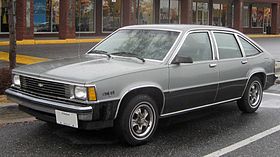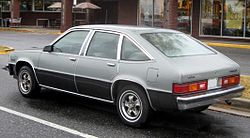Chevrolet Citation
This article needs additional citations for verification. (January 2010) |
| Chevrolet Citation | |
|---|---|
 | |
| Overview | |
| Manufacturer | Chevrolet (General Motors) |
| Production | 1980–1985 |
| Assembly | Oklahoma City, Oklahoma, U.S. North Tarrytown, New York, U.S. Ramos Arizpe, Mexico |
| Body and chassis | |
| Class | Compact |
| Body style | 2-door notchback 3-door hatchback 5-door hatchback |
| Layout | Transverse front-engine, front-wheel drive |
| Platform | X-body |
| Related | Buick Skylark Oldsmobile Omega Pontiac Phoenix |
| Powertrain | |
| Engine | 2.5 L Iron Duke I4 2.8 L LE2 V6 2.8 L LH7 HO V6 2.8 L LB6 MPFI V6 |
| Transmission | 3-speed TH-125 automatic 4-speed manual |
| Dimensions | |
| Wheelbase | 104.9 in (2,664 mm) |
| Length | 176.7 in (4,488 mm) |
| Width | 68.3 in (1,735 mm) |
| Height | 53.9 in (1,369 mm) |
| Chronology | |
| Predecessor | Chevrolet Nova |
| Successor | Chevrolet Corsica Chevrolet Beretta |

The Chevrolet Citation is a compact car marketed by Chevrolet for model years 1980–1985 in two-door coupe, three-door hatchback, and five-door hatchback bodystyles. Introduced in April 1979 for model year 1980,[1] the Citation superseded the Chevrolet Nova.
The Citation was significantly downsized compared to the Nova it was replacing. As a variant of the GM X platform, the Citation was adapted for front-wheel drive and was manufactured with badge engineered variants including the Buick Skylark, Oldsmobile Omega, and Pontiac Phoenix.
After its discontinuation in 1985, the Citation was replaced by the Chevrolet Beretta coupe and Chevrolet Corsica sedan/hatchback, introduced in 1987. 1,642,587 Citations were manufactured during its production run.[1]
Development
To better compete in the compact segment following the 1973 fuel crisis, General Motors commenced work in April 1974 on replacing its X-body compact lines, following slow sales of full-size domestically-produced vehicles in favor of smaller import cars. Sales of the latter spiked following the Arab oil embargo of 1973 and its resulting gasoline shortages. While the Chevrolet Monza proved relatively successful, it was outdated and inefficient compared to front-wheel drive compacts such as the Honda Accord and the Volkswagen Rabbit; based on its success, the layout of the latter would be copied nearly outright by Chrysler upon the introducton of the Dodge Omni/Plymouth Horizon for the 1978 model year.[citation needed]
While GM had been producing front-wheel drive cars for nearly a decade, the Cadillac Eldorado and Oldsmobile Toronado were neither fuel-efficient nor compact. In the mid-summer of 1976, the company produced its first prototypes of the cars intended to replace the X-Body; the Chevrolet Nova replacement was intended to be called the "Condor". Intended for a 1978 model release (alongside the downsizing of the mid-size car line), the X-body was delayed until the 1980 model year due to parts supply issues; GM parts suppliers were trying to adjust to the large-scale production of a front-wheel drive car. During the delay, the Chevrolet Condor name was changed to Chevrolet Citation.[2]
History
Introduced as the replacement for the Chevrolet Nova, the Chevrolet Citation became the first Chevrolet-brand car sold with front-wheel drive. As part of the downsizing of the overall Chevrolet product line, the Citation was 800 pounds lighter and 20 inches shorter than its predecessor (the Citation was 3 inches shorter than the Chevrolet Monza). With a wheelbase nearly 5 inches longer than a Chrysler K-Car, many interior dimensions of the Citation were comparable to the 1979 Nova.[1]
With over 810,000 sales, the Citation became the best-selling car in the United States for 1980.[1] Shortly after its launch, its sales fell sharply, facing competition from ai the sedan-bodied Dodge Aries and Plymouth Reliant launched in 1;9nd internal competitialso came from om the smaller 1982 Chevrolet Caval, available in several body stylespza). Issues over its production that affected the reputation of the Chevrolet Citation were poor build quality, poor mechanical reliability, and numerous manufacturer recalls. The General Motors X-body cars (the Citation and its Buick/Oldsmobile/Pontiac counterparts) were the target of an unsuccessful lawsuit by the U.S. National Highway Traffic Safety Administration (NHTSA), which cited a tendency to lose control under heavy braking and power steering problems.
1980
In April 1979, the Citation was released as a 1980 model. Two trim levels are available, with a standard trim and a sporty X-11 version.[1]
Priced under US$6,000, with hatchbacks in a much larger package than the Dodge Omni/Plymouth Horizon, demand proved very high for the Citation. Helped by an April release and yet another gasoline shortage during the same time, over 800,000 Citations were sold by Chevrolet for the model year. However, as the second gas crisis created demand for more fuel-efficient vehicles, GM was left with significant shortages of 4-cylinder engines, leading for some customers to wait several months to receive their vehicle. Before the fuel crisis, Chevrolet had anticipated 70% of customers purchasing the V6 engine option, leading to production lines unable to keep up with demand for 4-cylinder models.
The Citation was Motor Trend magazine's Car of the Year for 1980, a decision later criticized by the staff of Car and Driver in 2009, citing that the poor build quality and mechanical reliability were not deserving of such an award in hindsight.[3] Car and Driver and several other car magazines at the time were duped when GM lent them specially modified versions of the X-body vehicles in which heavy torque steer (for which they became infamous) had been engineered out. Patrick Bedard of Car and Driver said that they were completely surprised by this when they drove a production version some time later.[4]
1981
Following slow sales of the bodystyle, Chevrolet discontinued the 2-door version of the Citation for 1981.[1] To better differentiate it from standard models, the X-11 received a 135-hp H.O. "High Output" version of its 2.8L V6.[1]
1982
A major change for the 1982 Citation was the addition of fuel injection on 4-cylinder models.[1] Midway through the model year, the 2-door notchback sedan was returned to the lineup after being discontinued in 1981.[1]
For 1982, GM styled the X-platform into the front-wheel drive A-Body sedan, wagon and coupe as Chevrolet Celebrity and it's sister A-Body cars: Pontiac 6000 Oldsmobile Cutlass Ciera and Buick Century. N.B. The floorpan stampings of the A-Bodies are interchangable with the X-Body cars.
1983
1983 saw few changes to the Citation. New seats were added to the interior, while the HO V6 engine became an option for non X-11 Citations.[1]
1984
For 1984, the Citation saw relatively few changes. In an effort to stimulate interest in the line, which had been hurt by a reputation for poor quality and reliability, Chevrolet rebranded the model as "Citation II".[1]
1985
For 1985, the Citation II saw several revisions in its final year of production. Again, the 2-door coupe was discontinued, leaving only the hatchback models for sale. Inside, the dashboard was redesigned.[1] For the first time, the V6 engine line gained fuel injection.[1]
The last Citation rolled off the assembly line on June 21, 1985.
Powertrain
In addition to the X platform, GM also created a new line of engines for the Citation and its sisters. The 2.8 L LE2 V6 was the first of the 60°Family of engines. The X platform was used in 1982 as the basis for the new front-wheel drive A-body cars. The X platform was also the basis for the future L-body and N-body cars.
X-11

With the performance-enhanced Citation X-11, Chevrolet wanted to remind the car buying public that this front wheel drive newcomer was made by the same people as the Corvette and Camaro. The SCCA classified the X-11 in Showroom Stock B class. Bob McConnell drove a 1981 X-11 to SSB National Championships in 1982 and 1984.
The 1980 Citation X-11 had front and rear stabilizer bars, standard 4 speed overdrive manual or the optional 3 speed automatic, sport type suspension, Goodyear P205/70R-13 white lettered tires with rallye rim trim, a rear spoiler, side striping, black grill and body accents, sport steering wheel, body-color dual sport mirrors, Special full Instrumentation with a 6000 rpm tach, standard Pontiac 2.5-liter 4 cyl Iron duke or the optional Chevrolet 2-bbl LE2 2.8-liter V6 engine that produced 115 hp (86 kW).The 1980 Citation X-11 transmissions had special gearing to allow 60 mph (97 km/h) in second and a move up of first to help fill the stretch. The 1980 Citation X-11 was available only on the 2-Door Hatchback Coupe and Club Coupe (Notchback).
The 1981 to 1985 Citation X-11 models had legitimate performance upgrades such as a 2-bbl 2.8 V6 LH7 High Output engine, including Tuned High-Flo Exhaust with Dual-Tipped Muffler, F41 sport suspension, rear spoiler, special axle ratios, special full instrumentation with a 7000 rpm tach, front and back stabilizer bars, 14" specific alloy wheels with the word "Citation" cast in, Goodyear Eagle GT P215/60 R14 radial tires, functional fiberglass cowl induction hood with "High Output V6" logo and also on the air filter housing on the 81–84 X-11 models, dual sport mirrors, "strobe" style X-11 graphics on the lower side doors and rear spoiler, standard 4-speed overdrive manual or the optional 3-speed automatic, both with special gearing. The 1985 Citation X-11 had a MPFI version of the 2.8 L V6 LB6 and a nonfunctional fiberglass cowl induction with 2.8 F.I. Multiport Logo. The 4-speed manual overdrive was listed on the 1985 Chevrolet Citation brochure, but it was mentioned that it wasn't available, and the 3-speed automatic was the only transmission available for 1985.
Handling in the 1982 model was improved by relocating the steering rack from the firewall to the engine/front suspension subframe. This prevented subframe movement from affecting steering.
The 2.8 V6 H.O. LH7 engine was more powerful in the 1981 version of the X-11. It produced 135 hp (101 kW) and 165 lb⋅ft (224 N⋅m) of torque. The car accelerated from 0–60 MPH in 8.5 seconds. The 1982 through 1984 versions of the 2.8 V6 H.O. LH7 produced 135 hp (101 kW) but the torque was down to 145 lb⋅ft (197 N⋅m), due to emission regulations. These cars accelerated to 60 mph (97 km/h) in 9.2 sec. The 1985 Citation X-11 had a multi-port fuel injected 2.8 V6 LB6 engine which produced 130 hp (97 kW) and 155 lb⋅ft (210 N⋅m) of torque. The 1981 Citation X-11 is also faster than the 1985 model.[citation needed]
References
- ^ a b c d e f g h i j k l m The Auto Editors of Consumer Guide. "Chevrolet Citation". HowStuffWorks.com. Retrieved 2010-01-23.
{{cite web}}:|author=has generic name (help) - ^ "Chevrolet Citation (thing) by schizophasic - Everything2.com". everything2.com. Retrieved 2015-11-14.
- ^ "Dishonorable Mention: The 10 Most Embarrassing Award Winners in Automotive History". www.caranddriver.com. Retrieved 2012-06-29.
- ^ "The Skeptic has a Malibu Moment – Column – Auto Reviews". Car and Driver. Retrieved 2010-05-01.
